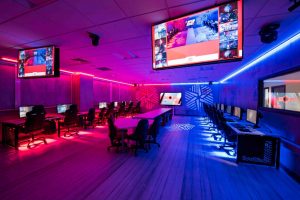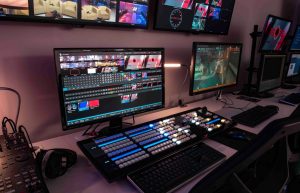eSports education: How Staffordshire University created a degree course for the expanding industry
“Whatever equipment our students use and whatever facilities we put in place, we always make sure we’re meeting one expectation: that students will get the best possible experience in readiness for the jobs they want when they graduate.” So says Christopher Leese, technical specialist for the Media & Communications department at Staffordshire University.
Of course, that’s not an uncommon mission statement for anyone in higher education. But what’s not so common is that the jobs to which Leese is referring are in an industry that didn’t even exist just a few years ago — eSports.
And that meant when it came time for the University to build a new facility to prepare students for future careers in eSports, Leese and his colleagues had to put aside equipment that had worked in the past and look to a new generation of technology.

The eSports hub at Staffordshire University
Staffordshire University, located in Stoke-on-Trent in England, has a notable history when it comes to teaching technology. The campus’s roots date back more than a hundred years, to the site of a school of science and technology that opened in 1914. Today it offers no fewer than four bachelors’ degree programmes in video games. It has previously been ranked best business school in the world for its use of Twitter. And it pioneered the world’s first Games PR and Community Management degree.
“With that background, it was just a natural levelling-up for Staffordshire University to become the first in the UK to offer a degree programme dedicated to the business of eSports management,” stated Leese.
He continued, “Our Year One compulsory modules encompass Competitive Gaming Culture, Resourcing Esports Events, Esports Ecosystems, Single Player Esports Event, Esports Events Experience and Esports Broadcasting. In fact, it’s the first of its kind in the United Kingdom, focusing strictly on the business of an emerging industry that in 2019 expects to see record revenues, thanks in large part to the influx of companies and investors getting into the market.
“All of which means our Bachelor of Arts in Esports (Honours) has a vital part to play in preparing students for a career in this exciting market.”
Variety of roles
As Leese points out, jobs in eSports aren’t limited to the players sitting in front of the game consoles. For companies to make money in esports, just like any other sport, it takes more than just athletes — it demands a whole ecosystem of specialisations.
These jobs can include highly visible roles like on-camera shoutcasters (another name for a commentator, who will explain the action) and hosts, coaches and analysts, to behind-the scenes professionals including event managers, partnership and sponsorship representatives, production crews, team or organisation managers, finance specialists, PR executives and, of course, production crews.
The course developers turned to the technical specialists in the Media & Communications staff to specify and deploy the equipment and infrastructure for the new facility. The technical staff were already responsible for running, supporting and maintaining the gear used in the school’s other production studios.
“The newsroom that we have here is a four-camera studio in a typical ‘newsy’ setup with green screen and lighting,” says Leese. “Students in the school’s television studies or sports journalism programmes, for example, produce live news shows and special broadcasts, and report from the football grounds, all using mostly conventional broadcast equipment. But we knew it wouldn’t be the same for eSports.”
Unique demands
The eSports Hub would require 4K streaming, as well as vision mixing large numbers of simultaneous, high-resolution computer sources over the network together with 4K camera sources, graphics and audio.
“Because this was a new venture for us, it had to be something that was going to be flexible, something we could expand on if we had to make changes at any point. It was clear that investing in traditional broadcast equipment was not going to be sufficient. We had to look into future capabilities – and, of course, we had to go IP.”
With all those considerations in mind, Staffordshire University opted for NewTek as its major equipment supplier.
“We’re not training students to be broadcast engineers, so we don’t need to delve into in-depth lessons about how signals are routed or how equipment is cabled,” explained Leese. “It’s got to be something that they can easily pick up. And that was one of the biggest selling points for going to NewTek.”
The technical staff designed a workflow around NDI, NewTek’s encoding technology for delivering frame-accurate video over IP, and circumvented conventional video routers altogether.
Using every day, standard 1Gb IT connectivity, the new facility can run 13 high-frame-rate, high-resolution gaming workstations over the network simultaneously, with NDI Scan Converter software making each gamer’s PC available as video sources.
This allows productions to be configured for two teams of six players, plus a connected ‘spectator

Heart of the system is a 44-input NewTek VMC1
mode’ workstation to determine which in-game feeds will be used. Game consoles such as Nintendo Switch or PlayStation can be added to the network via NewTek Spark Pro, converting HDMI video devices to NDI sources.
Vision mixing for all gaming PCs and consoles (plus graphics and audio) is centralised in the 44-input NewTek VMC1, which, with its associated two-stripe control panel, is “student friendly” enough to be operated without ongoing staff support.
In addition to the networked inputs from the computerised sources, the facility has three studio cameras as well as a ceiling-mounted PTZ camera, all with 4K signals converted to SDI using converters, and then brought into the VMC1 via a pair of NewTek NC1 I/O modules so that they’re available for mixing and monitoring over IP as well. Only the VMC1 has a 10Gb network connection.
A dedicated switch isolates the eSports hub from the University’s administrative network, keeping additional traffic from slowing it down. “All in all,” said Leese, “the project involved far more IT connectivity and networking than we had implemented before.”
The ease of NDI
“Doing this project really pushed our knowledge forward massively in terms of broadcast technologies and also networking,” he said. “We didn’t have years of extensive knowledge beforehand, but the technology available made us fairly comfortable with going into it and doing it ourselves.
“With traditional workflows, most facilities of a similar scope would require consulting with broadcast engineers and specialists. It just speaks volumes about how easy it is to use NDI.”
Within a short time of the course opening, the students were expanding on and developing different elements to incorporate into it. For example, the school hosted a recent broadcast event, showing the eSports varsity (or eVarsity) team playing against another local university.
“They’ve got the NewTek equipment that they like to use, and they’ve got the training. Now they can effectively do the whole production on their own”
The students wanted to take the feed from the broadcast studio on one part of the campus to a social venue about half a mile away — and at the same time, pull a camera feed from that location back to the studio and use it as part of the broadcast.
“With traditional setups we wouldn’t have been able to do that. We just wouldn’t have had the cabling in place to send over the signal, and streaming it would have added a massive delay. NDI has already allowed us to expand and achieve new capabilities that we’d never have done with a broadcast studio.”
He mentions another event coming up that will be completely driven by the students, who are now scheduling their own independent competitions. Because it will take place over the weekend, they won’t have any technical support from staff.
“That’s no problem,” stated Leese. “They’re already self-sufficient. They’ve got the NewTek equipment that they like to use, and they’ve got the training. Now they can effectively do the whole production on their own.”

